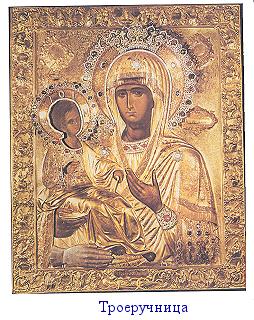Icon of Mother of God "The Three-Handed"
The origin of this miracle-working icon is closely linked with the name of St. John of Damascus, a noted writer, poet and Church figure. In 717, Byzantine Emperor Leo the Isaurian decided to destroy St. John by defaming him in the eyes of the Pnnce of Damascus. To Lhis end, Leo commissioned a skilful scribe to forge a leller, ostensibly sent to him by St. John, with a proposal to capture the inadequately fortified city of Damascus and forwarded that letter to the Prince, The Prince believed llie Emperor's libel and ordered to cut off St. John's hand and exhibit it in the city's main square as a warning to other traitors. Some time later, the Prince took pity on St. John and gave him his cut-off handback. Having received it, St. John fell on his knees before an icon of the Mother of God and began to beg Her for a cure. Later, when he fell asleep, the Mother of God appeared to him in a dream and told him thai his hand had been healed. When he opened his eyes, he saw that his hand was sound again, after which he decided to devote himself to monastic life. As a token of gratitude for the miracle, St. John made a silver representation of his hand and attached it to the icon. In Russia, copies of this miracle-working icon have been known since the 18th century. In 1880. a special office with an akathistos in honor of this icon was instituted. Feast days: June 28/July 11 and July 12/25.

